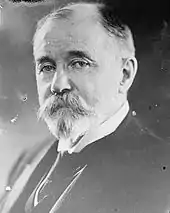Mount Lawson (Washington)
Mount Lawson is a 5,401-foot (1,646 m) mountain summit in Jefferson County of Washington state.[3]
| Mount Lawson | |
|---|---|
.jpg.webp) North aspect | |
| Highest point | |
| Elevation | 5,401 ft (1,646 m)[1][2] |
| Prominence | 2,541 ft (774 m)[2] |
| Parent peak | Mount Christie (6,181 ft)[2] |
| Isolation | 2.71 mi (4.36 km)[2] |
| Coordinates | 47°39′23″N 123°35′18″W[3] |
| Naming | |
| Etymology | Victor Lawson |
| Geography | |
 Mount Lawson Location of Mt. Lawson in Washington  Mount Lawson Mount Lawson (the United States) | |
| Country | United States |
| State | Washington |
| County | Jefferson |
| Protected area | Olympic National Park |
| Parent range | Olympic Mountains[4] |
| Topo map | USGS Mount Christie |
| Geology | |
| Age of rock | Eocene |
| Climbing | |
| Easiest route | class 2 hiking[1][2] |
Description
Mount Lawson is part of the Olympic Mountains and set within Olympic National Park and the Daniel J. Evans Wilderness. It is located 11.18 miles (17.99 km) south-southeast of Mount Olympus and the nearest higher neighbor is Mount Zindorf, 2.49 miles (4.01 km) to the northwest.[2][4] Precipitation runoff from the mountain drains to the North Fork Quinault River and topographic relief is significant as the summit rises 3,800 feet (1,200 m) above the river in 1.3 miles (2.1 km).
History
This peak was originally named "Mount Grady" by the 1889-90 Seattle Press Expedition to honor Henry W. Grady, editor of the Atlanta Constitution newspaper, and the expedition applied the Mount Lawson toponym to the 4,810-foot peak which is 1.4 miles (2.3 km) southwest. An 1896 National Geographic map labeled the landform "Jingo Peak." Over the years mapmakers shifted the Lawson name to its present position while the Grady and Jingo names fell into disuse and today Peak 4810 is officially unnamed.[5][6]

The mountain's toponym honors Victor Lawson (1850–1925), the publisher of the Chicago Daily News and president of the Associated Press from 1894 through 1900.[1][6] The mountain's toponym has been officially adopted by the United States Board on Geographic Names.[3]
Climate
Based on the Köppen climate classification, Mount Lawson is located in the marine west coast climate zone of western North America.[7] Most weather fronts originate in the Pacific Ocean, and travel northeast toward the Olympic Mountains. As fronts approach, they are forced upward by the peaks of the Olympic Range, causing them to drop their moisture in the form of rain or snowfall (Orographic lift). As a result, the Olympics experience high precipitation, especially during the winter months. During winter months, weather is usually cloudy, but due to high pressure systems over the Pacific Ocean that intensify during summer months, there is often little or no cloud cover during the summer.
Geology
The Olympic Mountains are composed of obducted clastic wedge material and oceanic crust, primarily Eocene sandstone, turbidite, and basaltic oceanic crust.[8] The mountains were sculpted during the Pleistocene era by erosion and glaciers advancing and retreating multiple times.
References
- Olympic Mountain Rescue, Olympic Mountains: A Climbing Guide, 4th Edition, 2006, Mountaineers Books, ISBN 9780898862065, page 213.
- "Lawson, Mount - 5,401' WA". listsofjohn.com. Retrieved 2023-07-19.
- "Mount Lawson". Geographic Names Information System. United States Geological Survey, United States Department of the Interior. Retrieved 2023-07-19.
- "Mount Lawson, Washington". Peakbagger.com.
- Robert Wood, Across the Olympic Mountains: The Press Expedition, 1889-90, Mountaineers Books (1988), ISBN 9781594858284
- Parratt, Smitty (1984). Gods and Goblins: A Field Guide to Place Names of Olympic National Park (1st ed.).
- Peel, M. C.; Finlayson, B. L.; McMahon, T. A. (2007). "Updated world map of the Köppen−Geiger climate classification". Hydrol. Earth Syst. Sci. 11: 1633–1644. ISSN 1027-5606.
- Alt, D.D.; Hyndman, D.W. (1984). Roadside Geology of Washington. pp. 249–259. ISBN 0-87842-160-2.
External links
- "Olympic National Park". National Park Service.
- Weather forecast: Mount Lawson